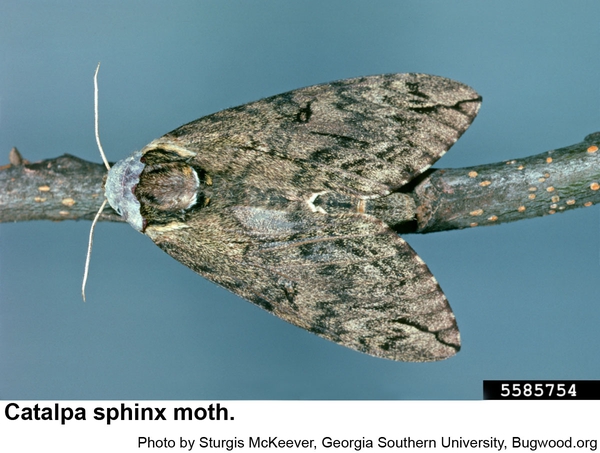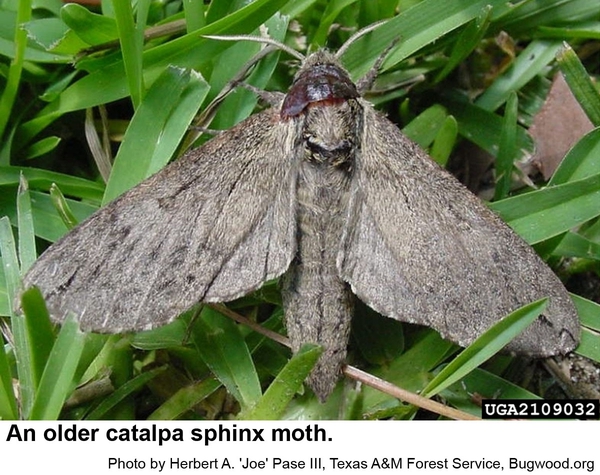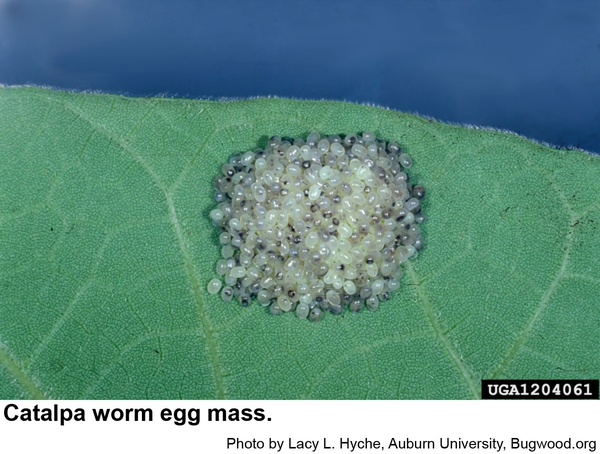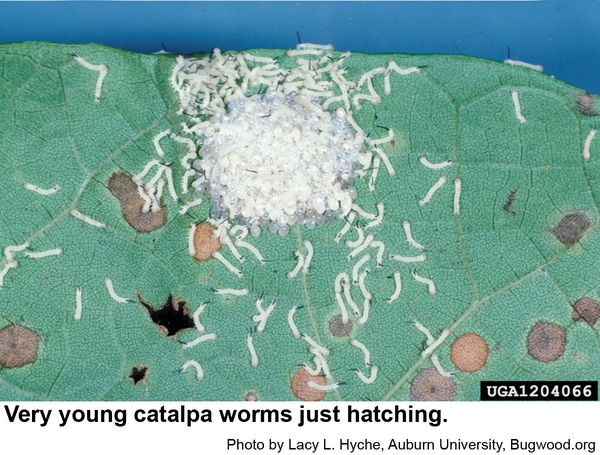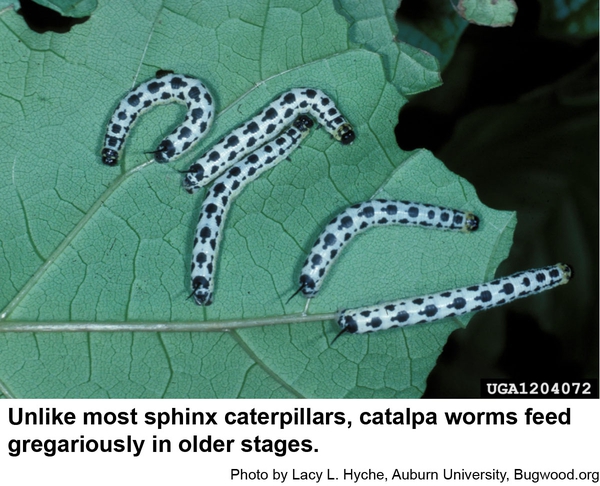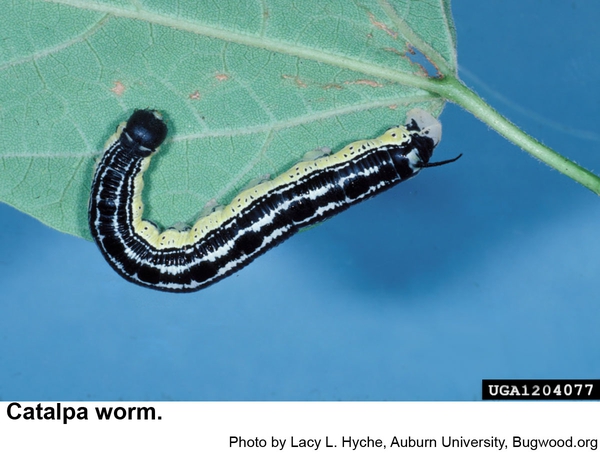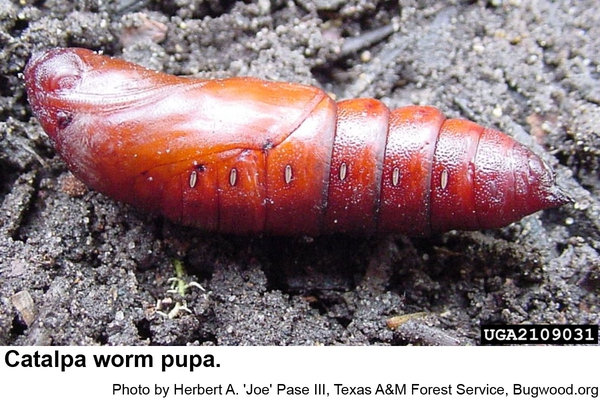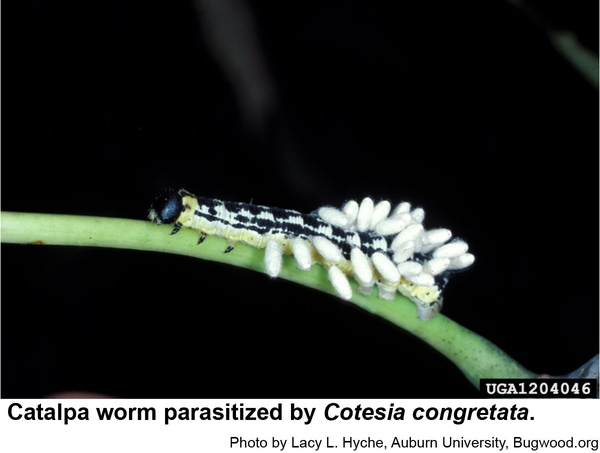Description and Biology
The catalpa worm or catawba worm, Ceratomia catalpae, is more formally known as the catalpa sphinx. The catalpa sphinx moth has a heavy body and a wingspread of about three inches. The wings and body are gray with irregular dark and light bands and markings. The hind wings are almost uniformly brownish gray. The antennae are white or very pale. Eggs are laid in masses of 100 to 1,000 on the undersides of leaves, on twigs, and on branches. Eggs are very small, pale, and yellowish. The mass may be ¾ inch across. Very young worms are tiny and pale, but already have noticeable horns. Young caterpillars are mostly white with black spots. Older catalpa worms may be strikingly different. Some larvae are black on top and pale yellow underneath. A light form is pale yellow with markings and patches of black on top, and some are intermediately marked. All forms have a stiff "horn" near the end of the abdomen that is straight, and black and longer than those of other hornworm species. Mature worms are up to 3 inches long. (Regardless of color patterns, catalpa worms are the only species of sphinx moth that that feed on catalpa, so positively identifying the host plant identifies the caterpillars. Catalpa sphinx pupae are spindle-shaped, light to dark brown, about 1½ inches long, and usually occur 2 or 3 inches down in the soil.
Pupae overwinter in soil around the base of the host tree. Adult moths begin to emerge in March or April and fly through October. Moths are sometimes attracted to lights. Catalpa worms are noticeable from May through November. Catalpa worms are the only sphinx moth caterpillars that feed gregariously through the third and sometimes fourth molts. We have several generations per year in North Carolina. Mature worms crawl down and dig into soil 2 to 3 inches deep under infested trees and pupate (no cocoon). After full development, pupae work their way to the soil surface and moths emerge very shortly.
Host Plants
Catalpa is the only know host of the catalpa sphinx including native northern and southern catalpas as well as Chinese catalpa. All are occasionally planted as an ornamentals. Catalpa worms feed exclusively on catalpa trees, sometimes completely defoliating them.
Residential Recommendations
Catalpa worms are attacked by a number of natural enemies, including various wasp and fly parasites. The most noticeable parasite is Cotesia congregata, a tiny wasp that emerges from the worm and spins a cocoon on the worm's skin. Folks sometimes misidentify the cocoons as worm eggs. A single worm may be covered in dozens of white cocoons. In addition, the giant strong-nosed stink bug is a fearsome predator of catalpa worms. These worms make excellent fish bait and about half of the catalpa worm inquiries we receive are about how to rear them or how to control parasites and predators that feed on the worms. Although these worms are great for fishing (the worms can even be frozen for later use!), some amateur horticulturists may not be too happy about catalpa trees being stripped of leaves every summer. Sevin, one of the Bacillus thuringiensis pesticides, or any of the insecticides labeled for landscape use should give adequate control especially when the catalpa worms are small.
Other Resources
- Catalpa Sphinx. Anonymous. No Date. Field Guide to Common Texas Insects. Texas A&M AgriLife Extension.
- Catalpa Worm/ Catalpa Sphinx Moth. Skvarla, M. J. PennState Extension.
- Insects of Eastern forests. Drooz, A. T. editor. 1985. USDA Forest Service Misc. Publication 1426. 608 pp.
- The Catalpa Sphinx. Hyche, L. L. 2013. Alabama Agricultural Experiment Station Leaflet 106.
- NC State Extension Plant Pathology Publications
- NC State Horticultural Science Publications
- North Carolina Agricultural Chemicals Manual
For assistance with a specific problem, contact your local N.C. Cooperative Extension center.
This factsheet has not been peer reviewed.
Publication date: May 24, 2021
Recommendations for the use of agricultural chemicals are included in this publication as a convenience to the reader. The use of brand names and any mention or listing of commercial products or services in this publication does not imply endorsement by NC State University or N.C. A&T State University nor discrimination against similar products or services not mentioned. Individuals who use agricultural chemicals are responsible for ensuring that the intended use complies with current regulations and conforms to the product label. Be sure to obtain current information about usage regulations and examine a current product label before applying any chemical. For assistance, contact your local N.C. Cooperative Extension county center.
N.C. Cooperative Extension prohibits discrimination and harassment regardless of age, color, disability, family and marital status, gender identity, national origin, political beliefs, race, religion, sex (including pregnancy), sexual orientation and veteran status.

